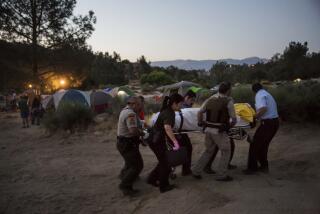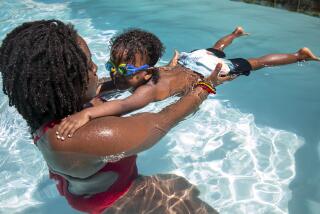How to Avert the ‘Drowning Season’ : * Any Children Under 5? Don’t Have a Swimming Pool
- Share via
The signs of approaching summer are visible everywhere. Patio furniture is being uncovered. Students are counting the days until school ends. People are cleaning and preparing their back-yard pools for the warm weather.
And sad to say, doctors and emergency personnel are getting ready too. They’re bracing for the needless accidents and drowning deaths that tragically seem to go with the territory of having swimming pools in back yards.
According to County Health Care Agency statistics, each year as many as 100 children under age 5 drown or nearly drown. For youngsters between the ages of 1 and 4, drowning has consistently been the leading cause of death. Orange County, perhaps because it has more than 100,000 back-yard pools, sadly has had more pool drownings than most any other area of the nation. Not all youngsters who fall into pools drown. Many survive, but often they suffer brain damage that leaves them mentally retarded for life.
Although the coming months have been dubbed the “drowning season,” drownings in fact happen all the time. The deadly risk is always there whenever a child and a back-yard swimming pool or spa are anywhere near each other. But there are more drownings when the warm weather sets in, doors are left open and children, unsupervised even for a moment, are outside and drawn to the pool.
The scenario is painfully familiar. The child wanders away from adults who are distracted, however briefly, by a phone call or some chore. The child manages to get into the back yard. The adult notices the child is missing. The frantic search begins. And the child is found, too often, too late, floating lifeless in the pool.
Hundreds of people took part in the “Mayday” pool safety course held in 19 different locations throughout the county Saturday and many more should have. The courses were designed to help prevent children from drowning. They attempted to impress pool safety and drowning prevention upon adults, and teach them how to perform cardiopulmonary resuscitation on infants and young children. CPR is something that every parent with a back-yard pool should know.
The tragedy is that drowning, which consistently has been the leading cause of death of children under the age of 5, is predictable and preventable. It need not happen. The law requires that we put children in seat belts in the family car. But the chance of a child drowning in a back-yard pool is 14 times greater than dying in an auto accident.
Still, after more than a year of study, there is no uniform pool safety ordinance that can be used countywide. Most communities require fencing around three sides of a pool. That helps keep people off the property, but it provides no protection between the house and the pool. Nor do many local ordinances in Orange County and elsewhere require pool covers, alarms or self-locking latches on all doors leading to the pool. In a split 3-2 vote several days ago, the Irvine City Council rejected a tougher pool ordinance.
Four-sided fencing is considered the best maximum safeguard along with other “layers” of protection, including pool covers, alarms and self-closing and self-latching gates. Having a telephone near the pool to save time calling 911, and knowing CPR, are also recommended.
The most effective protection, however, according to a county committee studying drowning prevention, is to remove the hazard: Don’t have a pool or spa if you have a child under the age of 5. In back yards where both are present, constant adult vigilance is needed to monitor the deadly combination.
More to Read
Sign up for Essential California
The most important California stories and recommendations in your inbox every morning.
You may occasionally receive promotional content from the Los Angeles Times.













